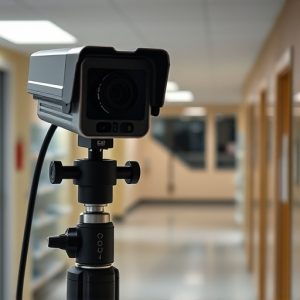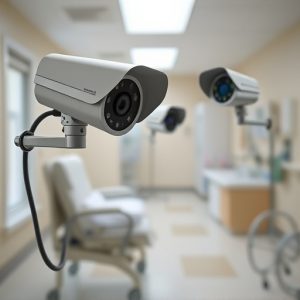Balancing Privacy and Protection: A Guide to Camera Use in Nursing Homes
The ethical deployment of cameras in nursing homes is a complex issue that requires careful consider…….
The ethical deployment of cameras in nursing homes is a complex issue that requires careful consideration of privacy and safety. Cameras can prevent neglect, abuse, and enhance staff accountability, offering reassurance to families while safeguarding resident well-being. However, their use must be balanced with respect for individual privacy and compliance with laws like HIPAA. The best camera systems for nursing homes include high-definition CCTV with night vision, motion detection, audio functions, and pan-tilt-zoom capabilities, all integrated with other safety measures to protect residents without compromising their dignity or autonomy. Data security is paramount, with secure storage and encryption of information. Facilities must engage stakeholders, including residents or their representatives, in decision-making regarding the use of cameras, ensuring they are used transparently and within the scope of consent. Transparency about surveillance practices, adherence to privacy laws, and protection against data breaches are essential to maintain trust and integrity within these care environments. Regular audits ensure ongoing legal compliance and adaptability to facility needs, making cameras for nursing homes a vital tool for enhancing safety and quality of life without infringing on personal space or freedom.
The intersection of privacy and safety within nursing homes is a delicate balance, especially with the advent of advanced surveillance technologies. As we explore the necessity and implementation of camera systems in these facilities, it’s crucial to consider the impact on resident well-being and staff accountability. This article delves into the types of cameras most suitable for nursing homes, highlighting their features and the considerations necessary for ethical deployment. We will navigate the legal framework surrounding surveillance in elderly care, ensuring compliance with privacy laws while promoting a safe environment for residents. Additionally, we’ll outline best practices for effectively implementing a surveillance system, focusing on fostering trust and maintaining dignity among the elderly population. Key insights into cameras for nursing homes will provide valuable guidance for facilities seeking to enhance security without compromising personal privacy.
Evaluating the Necessity of Camera Installation in Nursing Homes: Balancing Privacy and Safety
The deployment of cameras for nursing homes is a topic that necessitates careful consideration, balancing the residents’ right to privacy with the imperative need for their safety and well-being. Advocates for camera installation argue that surveillance can deter neglect or abuse by staff or other residents, providing a safeguard against such compromises in care. In this context, strategic placement of cameras for nursing homes can offer peace of mind to both residents and their families, ensuring that the environment is conducive to compassionate care and respect for elders. However, it is crucial to implement surveillance measures with sensitivity and transparency; privacy must be respected, and guidelines should be established to regulate when and how footage is accessed and used. This includes clear protocols for staff conduct, data protection policies, and ensuring that residents or their representatives have a say in the matter. The goal is to create an environment where safety is prioritized without infringing on individual rights, leveraging technology as a tool to enhance quality of life rather than intrude upon it.
Types of Cameras Suitable for Nursing Homes: Features and Considerations
When selecting cameras for nursing homes, it’s crucial to prioritize features that ensure both the safety and privacy of residents, as well as the operational efficiency of staff. High-definition CCTV cameras with night vision capabilities are essential for monitoring common areas and entry points around the clock. These cameras should be discreet yet effective, blending into the environment without compromising security. In addition to high-resolution imaging, these cameras must comply with privacy laws, providing clear video while protecting residents’ dignity. Indoor and outdoor cameras with motion detection can alert staff to movements in restricted areas or emergencies, ensuring immediate response. Audio capabilities are also important for two-way communication, allowing staff to soothe residents or provide instructions remotely. Cameras for nursing homes should be equipped with secure data storage and encryption methods to protect sensitive information. Additionally, they must be easy to install and maintain by the facility’s technical team, ensuring continuous surveillance without overburdening staff resources. Pan-tilt-zoom cameras can offer a wider range of coverage, allowing security personnel to focus on areas of concern dynamically. The chosen system should also integrate with other safety features, like alarm systems or emergency call buttons, creating a comprehensive safety network for the well-being of nursing home residents.
Legal and Ethical Implications of Surveillance in Elderly Care Facilities
The deployment of surveillance cameras in nursing homes raises a multifaceted array of legal and ethical implications that must be carefully considered to uphold the privacy, autonomy, and dignity of elderly residents. Legally, facilities are required to comply with state and federal regulations governing the use of surveillance technology. This includes adherence to laws such as the Health Insurance Portability and Accountability Act (HIPAA), which protects the confidentiality and security of individual health information. Facilities must navigate these legal frameworks to ensure that the installation and operation of cameras do not infringe upon residents’ rights or privacy.
Ethically, the use of surveillance in elderly care facilities must be approached with a commitment to respecting the autonomy and well-being of each resident. It is crucial to balance safety measures with an environment that fosters trust and feels secure for the elderly. Transparency regarding the use of cameras is paramount; residents and their families should be fully informed about when, where, and how surveillance is employed, as well as who has access to the footage. Moreover, the data collected through camera systems must be safeguarded against unauthorized access or misuse, reinforcing the trust between caregivers and those in their care. The ethical use of cameras for nursing homes should be guided by principles that prioritize the rights and dignity of elderly individuals, ensuring that surveillance serves to enhance safety without compromising their personal space or freedom.
Best Practices for Implementing a Surveillance System in Nursing Homes: Ensuring Resident Well-being and Staff Accountability
The implementation of surveillance systems in nursing homes is a multifaceted endeavor that requires careful planning and consideration to ensure resident well-being and staff accountability. Cameras for nursing homes should be strategically placed to provide comprehensive coverage while respecting residents’ privacy. Best practices recommend installing cameras in common areas, such as dining halls, lounges, and corridors, where activities are more communal and oversight is necessary. These locations can help monitor for signs of neglect, falls, or other incidents that could compromise the safety of residents. Additionally, cameras should be used judiciously in private spaces to maintain a balance between security and personal boundaries. It’s crucial to involve stakeholders, including residents, families, and staff, in discussions about where and how surveillance will be implemented. This collaborative approach fosters trust and transparency while ensuring that the system aligns with the facility’s commitment to providing a safe and dignified environment.
To effectively manage data collected by nursing home cameras, robust data management protocols must be established. These protocols should outline access permissions, data storage, retention policies, and procedures for handling incidents captured on camera. Regular training for staff on the ethical use of surveillance footage is also paramount. This ensures that any monitoring activities are conducted in a manner that prioritizes resident safety without infringing on their rights. Furthermore, maintaining clear signage indicating areas under surveillance serves as a reminder to both residents and staff about the presence of cameras, further reinforcing the respect for privacy and the integrity of the surveillance system’s purpose. Regular audits and reviews of the surveillance system should be conducted to ensure compliance with legal standards and to adapt to changing needs within the facility.


